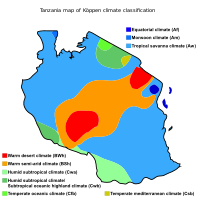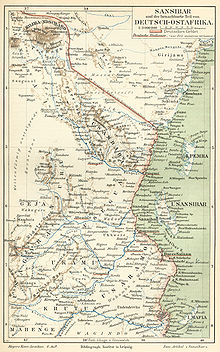Tanzania
![]()
This article is about the state; for the TV movie from the series Das Traumschiff see Das Traumschiff: Tansania.
Template:Infobox State/Maintenance/NAME-German
Tanzania ([tanzaˈniːa], also [tanˈzaːni̯a], officially United Republic of Tanzania, Swahili Jamhuri ya Muungano wa Tanzania) is a country in East Africa. It is located on the Indian Ocean, bordered by Kenya and Uganda to the north, Rwanda, Burundi and DR Congo to the west, and Zambia, Malawi and Mozambique to the south. Tanzania has been a member state of the Commonwealth of Nations since independence from the United Kingdom on 9 December 1961.
The country is the fifth largest country in Africa by population, with just under 56 million inhabitants. The capital of the state is Dodoma, but the largest city is the coastal city of Dar es Salaam; other large cities are Mwanza, Arusha, Mbeya, Morogoro and Tanga.
Tanganyika (comprising the mainland area with the island of Mafia) became independent from the mandate power Great Britain in 1961 and joined with Zanzibar (islands of Pemba and Unguja) in 1964 to form Tanzania, whose country name is composed of Tanganyika, Zanzibar and the designation Azania. About 125 languages are spoken in Tanzania, mostly Bantu languages, but also Nilotic and Cushitic languages, Arabic and Indian languages; lingua franca are Swahili and English.
Geography
The Tanzanian mainland consists of a 16 to 64 kilometre wide coastal plain with tropical vegetation, the Masai savannah between 200 and 1100 metres high in the north and a high plateau in the south (900-1200 metres), which reaches as far as Lake Malawi. The Central African Rift touches Tanzania in the west, the East African Rift runs centrally through the country. Witnesses to the geological processes in this tectonic fault zone are huge craters and volcanoes such as Mount Rungwe (2960 m), Mount Meru (4562 m) and the highest mountain in Africa, Kibo (5895 m). The territory of Tanzania borders three of the largest lakes in Africa: Lake Victoria to the north, Lake Tanganyika to the west and Lake Malawi to the south. In the northwest of Tanzania lies the Serengeti (Maasai language: "wide area", "great plain", "endless land"), one of the most famous national parks in Africa.
Wet and dry savannahs with umbrella acacias and baobab trees dominate much of Tanzania. Semi-deserts and coastal plains (some with mangrove swamps) make up the rest of the landscape.
See also: National parks in Tanzania
In the north-east of the country, not far from the border with Kenya, rises the highest mountain massif in Africa, the Kilimanjaro massif, the highest point of which - Uhuru Peak - is Mount Kibo (5895 m).
Climate
Along the flat coast, the climate is tropical, while in the mountains to the north, south (Mbeya Range, Poroto Mountains, Livingstone Mountains, Kipengere Mountains, Kitulo Plateau) and west, the climate is temperate.
Hydrology
The East African country has a diverse hydrology. Due to very different climatic zones, precipitation either remains in basins without drainage from which it evaporates again (about ¼ of the country's area), or drains via the Congo (Lake Tanganyika) or the Nile (Lake Victoria) into oceans on the other side of the continent. Almost half of the catchment area, however, is accounted for by rivers that flow into the Indian Ocean. The largest catchment areas are those of the Rufiji (Indian Ocean), followed by the Malagarasi (Atlantic Ocean), which together drain almost 1/3 of the country.
See also: List of rivers in Tanzania

Kibo, the highest mountain in Africa

Climate zones in Tanzania
History
→ Main article: History of Tanzania
The coastal region of East Africa was already part of a long-distance trading system from the beginning of our era, in which it was connected to the Red Sea by sailing ships. From about the 8th to 9th centuries, the Swahili culture spread along the coast, giving rise to a chain of Islamic-influenced cities along the coast from trading posts. These settlements extended as far as Mozambique. On Tanzanian territory, Kilwa Kisiwani was the main town from the 14th to the 16th century. The intrusion of the Portuguese from the south, who established intermediate stations in East Africa on their route of communication to India, brought about a considerable disturbance of this trade. After ousting the Portuguese from the Kenyan-Tanzanian coastal area, Oman became the dominant coastal power.
From the 18th century onwards, coastal civilisation exerted considerable influence on the inland area through the East African caravan trade and the associated slave trade.
In the 19th century, the Sultan of Oman moved his capital to Zanzibar, intensifying his influence on the coast and hinterland. From 1885, the Society for German Colonization acquired claims to parts of the interior and attempted to establish a colony. Their rule collapsed in 1888 in the uprising of the East African coastal population, whereupon the German Empire used military forces to conquer the territories, which then became the colony of German East Africa, which included Rwanda and Burundi in addition to what is now mainland Tanzania. During World War I, the German Schutztruppe, led by Paul von Lettow-Vorbeck, resisted Allied forces until the end of the war. The colony was conquered by British and Belgian troops from 1916 and subsequently divided up among the victors.
The Tanzanian mainland came under British rule as Tanganyika Territory and was administered as a League of Nations mandate (after World War II as a UN Trust Territory).
Tanganyika gained independence from the United Kingdom on 9 December 1961. Shortly after Zanzibar declared independence on 10 December 1963, Tanganyika (Tan) and Zanzibar (San) merged on 26 April 1964, initially under the name United Republic of Tanganyika and Zanzibar. The republic was then renamed the United Republic of Tanzania about six months later on November 1, 1964. Julius Kambarage Nyerere of the Tanganyika African National Union (TANU) became the first president. In 1977, at Nyerere's instigation, TANU and Zanzibar's Afro-Shirazi Party (ASP) merged to form Chama Cha Mapinduzi (CCM for short). Nyerere and his followers sought to build a socialist society in Tanzania, nationalized the banks, and carried out educational and land reforms.
Nyerere's goal was a specifically African socialism in distinction to the authoritarian socialism models after the Soviet Union. The model for Tanzania's socialist transformation was instead to be the "Ujamaa", the village community as a production and distribution collective. However, the extension of the Ujamaa model to larger production units failed, and with the deterioration of economic conditions, so did Nyerere's socialist vision. He resigned as state president in 1985 and as party leader in 1990. Nyerere died in 1999.
In 1992 the one-party system ended, and in 1995 democratic parliamentary and presidential elections were held for the first time since the 1970s, although the previous ruling party CCM was able to maintain its position. The president was Benjamin Mkapa, who constitutionally did not stand for re-election after ten years in office. After Jakaya Kikwete had asserted himself within the CCM party, he was elected president in 2005. Presidential and parliamentary elections were held again on 31 October 2010. Losses were predicted for the CCM under Kikwete in favour of the Wilbrod Slaa-led CHADEMA. Kikwete was re-elected with about 61 percent of the vote, Slaa received about 26 percent, and Ibrahim Lipumba of the CUF received about 8 percent. After serving two terms, he was not allowed to run again in the 2015 elections.
(Gerald_Ford_Library)_(cropped)a.jpg)
Julius Nyerere, Chairman of TANU and until 1990 also of CCM, first Prime Minister of independent Tanganyika and until 1985 President of Tanzania (photograph from 1976)

Historical map (around 1888)
Questions and Answers
Q: What are the official languages of Tanzania?
A: The official languages of Tanzania are Kiswahili and English.
Q: How many people live in Tanzania?
A: In 2017, there were about 54,000,000 people living in Tanzania.
Q: How many tribes make up the population of Tanzania?
A: There are 120 tribes that make up the population of Tanzania; none have more than 10% of the population.
Q: What is the main religion practiced in Tanzania?
A: The main religions practiced in Tanzania are Christianity and Arabic.
Q: Who is the current president of the United Republic of Tanzania?
A: The current president of the United Republic of Tanzania is Samia Suluhu Hassan.
Q: When did mainland Tanganyika gain independence from colonial rule?
A: Mainland Tanganyika (now known as mainland Tanzania) gained independence from colonial rule in December 1961.
Q: What animals can be found in Serengeti National Park located within Tanzanian borders?
A: Animals such as lions and cheetahs can be found in Serengeti National Park located within Tanzanian borders.
Search within the encyclopedia